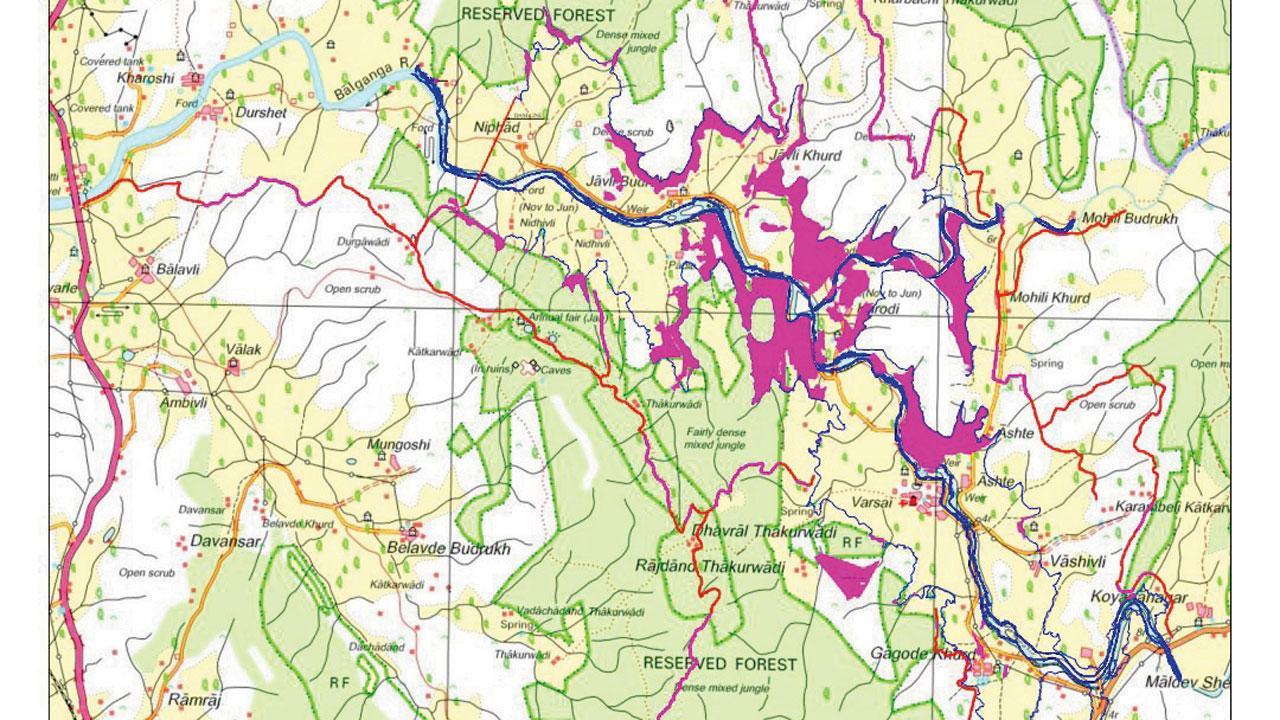216 ha of forest land to go under; Navi Mumbai’s growth cited as justification

The areas that will be submerged due to the project (in pink)
The Balganga River Project, which is expected to supply drinking and industrial water to Panvel, Nerul and Karjat, is expected to entirely submerge 216 ha of Raigad district’s forest land.
The state water resources department has sent a forest clearance proposal for the diversion of the land to the ministry of environment, forest & climate change (MOEF&CC). According to the proposal, the project—which is to come up in the district’s Pen taluka, is situated at the Balganga river—which originates from the Patalganga river basin and joins the Arabian Sea near Dharmatar creek.
The proposal reads, “Planned storage of the project is 144.69 mm3 and water storage is supposed to be used for drinking and industrial water supply to suburban areas of MMR region suburban-4 [New Mumbai], suburban-5 [Nerul, Karjat, Khopoli, Khalapur] and suburban-6 [Panvel and Uran].” The project is being executed by the Konkan Irrigation Development Corporation (KIDC) for the City and Industrial Development Corporation (CIDCO).
The project comprises an earthen dam that is 1,170 metres long and 40.15 metres tall. The water storage capacity of the dam is 144.168 million litres per day (MLD) while its live storage—the amount of water that can be released through the dam’s gates that can be used for flood control or to generate electricity—is 120.07 MLD.
Also Read: The big holes in BMC’s pothole-filling claim
The submergence area of the project comprises more than 14,200 ha of private land, 31.24 ha of government land and 253.36 ha of forest land and spans 13 villages—Jawali, Nifad, Karoti, Washivali , Ashte, Mohili Khalsa, Karambeli, Varsai, Padale, Nidhawali, Mohili Budruk, Gagode Budruk and Gagodekhurd.
The proposal says, “Navi Mumbai is growing fast with the proposed Navi Mumbai International Airport Project. Water demand in this region will grow substantially in the coming years. Water is supplied to Navi Mumbai from the assured source of the Hetawane Water Supply Scheme, NMMC’s Morbe dam project and MIDC’s Barvi Dam Project. The Balganga Dam Project will primarily supply water to areas under the Panvel Municipal Corporation and CIDCO nodes such as Kharghar, Kamothe, Kalamboli, Taloja, Dronagiri, Ulwe and Pushpak, and the Navi Mumbai International Airport.” A total of 1,854 families are being rehabilitated and the compensation distribution for them is in progress. It says 1,563.032 ha of non-forest land will be submerged.
A note on cost-benefit analysis for the forest land required for the project says, “It has been planned as a drinking water project for the augmentation of water supply for CIDCO and other areas so as to satisfy the demand for water in the future. The water available for drinking is 350 MLD throughout the year. Due to the construction of this project, the water table in the command area will rise to a considerable extent, resulting in saving on water supply during scarcity.” The note also says that the project will help increase tree growth. “Due to the creation of the reservoir, water will percolate through the adjoining forest along the reservoir periphery, It is assumed that about 200-metres wide forest area along the 35-km periphery of the reservoir will benefit.”
144.168
Storage capacity of the dam in million litres a day
 Subscribe today by clicking the link and stay updated with the latest news!" Click here!
Subscribe today by clicking the link and stay updated with the latest news!" Click here!










